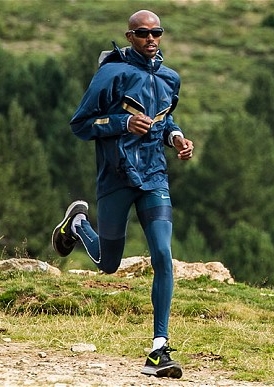Mo Farah has done it again! He won gold at the 2016 Olympic 10,000m finals. Absolutely, he has the will and mental drive to win, but he also has been trained to develop a smart biomechanical habit.
The Perfect Stride of Mo Farah
In the past, foot strike and leg swing mechanics were woefully underestimated in elite distance running. That is a shame because, when used properly, you’ll be able to outperform every time.
To maximize running economy, you must work on your biomechanics from the ground up, which is exactly what Alberto Salazar did when he re-engineered Mo Farah’s gait.
Salazar tweaked Farah’s form in a way that reflects sprinting mechanics: anterior foot strike, no over-striding (i.e. ankle lands under the knee at touchdown), no trailing leg (i.e. leg is rapidly pulled up to the buttocks to initiate the next stride). Note that Farah does have a long stride, he just doesn’t over-stride.
To reduce anterior leg swing activity (i.e. less forward leg swing and braking), Farah increased his cadence to promote more posterior leg swing activity –hence a higher back-kick. The advantage of such adjustments lowers energy cost at fast running speeds (speeds greater than 10 mph).
The brilliance of Farah’s refined gait is that it increases flight time. This means that Farah’s feet spend minimal time on the ground. Less stance time, or shorter support phase duration, reduces contact forces.
- For instance, horizontal forces, or the braking phase, makeup more than 33% of the total metabolic costs in running (Chang and Kram). Reducing ground contact through forefoot running would reduce this force.

The Take Home Message
Performance is walled by bad mechanics. Yet the core battle between better performance and injury prevention will remain, but can be fought through by forefoot running, even with the most delicate body frames (like most Kenyan runners).
Identifying components of Farah’s gait is a key step towards discerning running efficiency at its most fundamental level. Likewise, Farah’s gait illuminates fundamental forefoot running mechanics, running with success in a way even Salazar never achieved with his heel strike, shuffle.
Click here to learn about specific drills Farah used to improve his form.
More From Run Forefoot:
Patellofemoral Pain Syndrome – Many runners suffer this dreaded injury, but many runners don’t know why. This article covers the main cause of knee injury in runners.
Achilles Heel – Found out why heel strike running is such a daunting task for the Achilles tendon, resulting in injury to the tendon.
Eccentric Exercises – We often hear about eccentric exercises, but you can achieve them just by running barefoot; find out how.
Forefoot Shoe Review – Read my review on the FeelMax Osma 2, an under-appreciated forefoot running shoes that is a great tool to help you mechanically run your best.
References
Chang, YH and Kram, R. Metabolic cost of generating horizontal forces during human running. J Appl Physiol 86: 1657–1662, 1999.
French, J., Long, M and Cook, B. The Perfect Stride. Athletics Weekly, 2014, July. pp44.
Bretta Riches
BSc Neurobiology; MSc Biomechanics candidate, ultra minimalist runner & founder of RunForefoot. I was a heel striker, always injured. I was inspired by the great Tirunesh Dibaba to try forefoot running. Now, I'm injury free. This is why I launched Run Forefoot, to advocate the health & performance benefits of forefoot running and to raise awareness on the dangers of heel striking, because the world needs to know.
Latest posts by Bretta Riches (see all)
- Heel Strike Running Causes Bone Pain - 29/04/2024
- Heel Strike Running Causes Slipped Discs - 25/04/2024
- How to Train Yourself to Not Heel Strike When Running - 24/04/2024

Bretta don’t you also find Mo UNWEIGHS very well? He bounces lightly, like a gazelle, more that most runners I watch. I don’t hear much talk of unweighting except by Pose. I find conscious focus on it very liberating. I use my upward hand motion at the tail end of the forward arm swing as a trigger for the entire unweighting event, It seems to couple well (more than just psychologically) with muscle recoil, hamstring pull– and it even facilitates a stable torso, arms further back, easy belly breathing — many aspects of posture and its maintenance. The real athletic trick for me seems to be to distinguish unweighting from shoulder shrugging. It is your entire torso that unweights, though I’ve seen videos where Dr. R. explain/demonstrates it in terms of exaggerated bobbing shoulders..